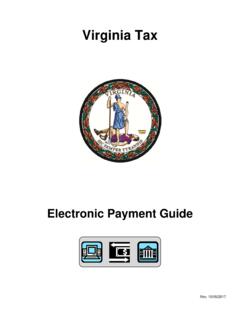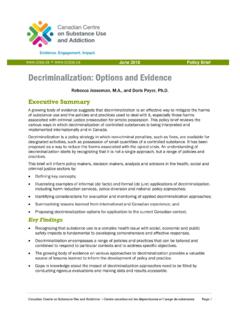Transcription of Tobacco and its environmental impact: an overview - WHO
1 Tobacco and its environmental impact: an overview Tobacco and its environmental impact: i/. an overview To b a c c o a n d i t s e n v i r o n m e n t a l i m p a c t : a n o v e r v i e w Tobacco and its environmental impact: an overview ISBN 978-92-4-151249-7. World Health Organization 2017. Some rights reserved. This work is available under the Creative Commons Attribution-NonCommercial- ShareAlike IGO licence (CC BY-NC-SA IGO;. ). Under the terms of this licence, you may copy, redistribute and adapt the work for non-commercial purposes, provided the work is appropriately cited, as indicated below. In any use of this work, there should be no suggestion that WHO endorses any specific organization, products or services. The use of the WHO logo is not permitted. If you adapt the work, then you must license your work under the same or equivalent Creative Commons licence. If you create a translation of this work, you should add the following disclaimer along with the suggested citation: This translation was not created by the World Health Organization (WHO).
2 WHO is not responsible for the content or accuracy of this translation. The original English edition shall be the binding and authentic edition . Any mediation relating to disputes arising under the licence shall be conducted in accordance with the mediation rules of the World Intellectual Property Organization. Suggested citation. Tobacco and its environmental impact: an overview . Geneva: World Health Organization; 2017. Licence: CC BY-NC-SA IGO. Cataloguing-in-Publication (CIP) data. CIP data are available at ii/ Sales, rights and licensing. To purchase WHO publications, see To submit requests for commercial use and queries on rights and licensing, see Third-party materials. If you wish to reuse material from this work that is attributed to a third party, such as tables, figures or images, it is your responsibility to determine whether permission is needed for that reuse and to obtain permission from the copyright holder. The risk of claims resulting from infringement of any third-party-owned component in the work rests solely with the user.
3 General disclaimers. The designations employed and the presentation of the material in this publication do not imply the expression of any opinion whatsoever on the part of WHO concerning the legal status of any country, territory, city or area or of its authorities, or concerning the delimitation of its frontiers or boundaries. Dotted and dashed lines on maps represent approximate border lines for which there may not yet be full agreement. The mention of specific companies or of certain manufacturers' products does not imply that they are endorsed or recommended by WHO in preference to others of a similar nature that are not mentioned. Errors and omissions excepted, the names of proprietary products are distinguished by initial capital letters. All reasonable precautions have been taken by WHO to verify the information contained in this publication. However, the published material is being distributed without warranty of any kind, either expressed or implied.
4 The responsibility for the interpretation and use of the material lies with the reader. In no event shall WHO be liable for damages arising from its use. Printed in Switzerland. To b a c c o a n d i t s e n v i r o n m e n t a l i m p a c t : a n o v e r v i e w Contents Foreword by Dr Oleg Chestnov, WHO Assistant Director-General v Foreword by Dr Vera Luiza da Costa e Silva, Head of the WHO FCTC Secretariat vi Foreword by Ahmad Mukhtar, Economist, Food and Agriculture Organization viii Acknowledgements ix Abbreviations xi Executive summary xii Introduction 1. 1 Tobacco growing and curing: impact on land and agriculture 4. Agrochemical use 4. Deforestation and land degradation 5. Farmers' livelihoods and health 8. 2 Manufacturing and distributing Tobacco products 11. Measurement 11. Voluntary corporate social responsibility versus regulation 12. Types of environmental costs 13. Resource use 14. Carbon dioxide (CO2) pollution 17. iii/. Transport 17. Use of plastics as packaging material 18.
5 Solutions 19. 3 Consumption 20. Tobacco smoke 20. Third-hand smoke pollution 22. 4 Post-consumer waste 24. Reducing harm caused by Tobacco product waste 24. Product waste 26. Waste disposal (landfill) 27. Recycled waste disposal 27. Hazardous waste 27. environmental manufacturing goals 27. To b a c c o a n d i t s e n v i r o n m e n t a l i m p a c t : a n o v e r v i e w 5 Calculating the economic cost 29. Determining economic implications 30. 6 Current frameworks and possible solutions 32. Relevant WHO FCTC articles 32. Industry accountability 34. Recommendations 36. The road ahead 37. Examples of major environmental treaties 39. Examples of international environmental organizations 40. References 41. iv/. To b a c c o a n d i t s e n v i r o n m e n t a l i m p a c t : a n o v e r v i e w Foreword by Dr Oleg Chestnov, WHO Assistant Director-General The fact that today most people are aware of the health impacts of using Tobacco is a victory for global health and well-being.
6 It moves us one step closer to a world where a billion people are less likely to die from the consequences of chewing, smoking or ingesting Tobacco . But successful advocacy to reduce the health impacts of Tobacco have not been matched by successes in challenging other impacts from Tobacco including on education, equality, economic growth, and on the environment all of which can affect a country's development. This overview opens the lid on a Pandora's Box containing the quieter but shockingly widespread impacts of Tobacco from an environmental perspective. The Tobacco industry damages the environment in ways that go far beyond the effects of the smoke that cigarettes put into the air. Tobacco growing, the manufacture of Tobacco products and their delivery to retailers all have severe environmental consequences, including deforestation, the use of fossil fuels and the dumping or leaking of waste products into the natural environment. Cigarettes pollute our air, as air quality testing has shown in major cities such as London and Los Angeles.
7 Long after a cigarette has been v/. extinguished it continues to cause environmental damage in the form of non-biodegradable butts . millions of kilograms of which are discarded every year. From start to finish, the Tobacco life cycle is an overwhelmingly polluting and damaging process. The explicit inclusion of a Tobacco reduction target in the UN Sustainable Development Goals (Target 3A) makes it clear that this product poses a significant problem for sustainable global development. The scale of the environmental damage resulting from Tobacco use, as described in this overview , makes clear how much more needs to be done both to monitor and counteract it. It also highlights the need for a collaborative approach to Tobacco control . In the past few years, health and finance authorities have come together to use taxation as a highly successful form of Tobacco control . Similar efforts could be made by environmental and health authorities, who already collaborate on shared concerns such as air pollution.
8 A united response is a strong response. Most importantly, the environmental consequences of Tobacco consumption move it from being an individual problem to being a human problem. It is not just about the lives of smokers and those around them, or even those involved in Tobacco production. What is now at stake is the fate of an entire planet. Only global action will create a solution for this global problem, and this overview aims to catalyze such action. To b a c c o a n d i t s e n v i r o n m e n t a l i m p a c t : a n o v e r v i e w Foreword by Dr Vera Luiza da Costa e Silva, Head of the WHO FCTC Secretariat The alarming rise in Tobacco consumption and related deaths has turned the battle for Tobacco control from one focused primarily on educating a sceptical public about Tobacco 's health threat to one involving public engagement on much broader fronts . including on the subject of this overview : the severe and noxious effects of Tobacco on the environment.
9 The articles and guidelines of the WHO Framework convention on Tobacco control (WHO FCTC) anticipate precisely this need to act simultaneously on multiple issues. Under Article 18 of the treaty, Parties agree to have due regard to the protection of the environment and the health of persons in relation to the environment in respect of Tobacco cultivation and manufacture within their respective territories . This overview is the result of a decision by the WHO FCTC's governing body, the Conference of the Parties (COP) at its 2016 meeting in Delhi, to invite WHO to consider the environmental impact of the Tobacco life cycle. It has been completed with commendable speed by WHO, providing a very useful summary which will be invaluable in informing future action. It is, as the authors acknowledge, the vi/ first step on a path to date largely neglected, and which now requires greater attention. The overview highlights the current lack of scientific research into the environmental impact of Tobacco , including the health and economic consequences that result from the cultivation, production, distribution, and waste of what is a highly addictive and unnecessary product.
10 The costs of such environmental damage are not always clear, leaving policy-makers often poorly informed on the true consequences of consumption. By omitting or minimizing these true costs, Tobacco companies can effectively shift their responsibility to the taxpayer, and thus enjoy a hidden subsidy. For example, cigarette manufacturing often involves long-distance distribution to other countries using diesel-powered lorries whose emissions have an established effect in causing cancer, heart attacks and strokes. The clean-up costs of Tobacco waste, like discarded cigarette butts, is generally borne by municipalities, as are the associated disposal costs for waste including heavy metals and poisons that leach from cigarette butts once in landfill, including arsenic. The evidence is not as detailed as required at least not yet but we have a good idea of where to look. There is a clear chain of environmental damage throughout the Tobacco cycle, from growing and curing to manufacturing and distribution; and from the effects of consumption (including second- and third-hand smoke) to post-consumption waste.















